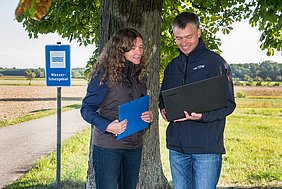Precautionary planning and risk-based approaches are addressed in the current EC drinking water directive. But their significance shall be emphasised much more strongly in the planned revision. Risk management in drinking water supply is a tool employed to deal with risks in a systematic way and prevent any issues to the security of supply.
The updated version of the EC drinking water directive has been extensively prepared and, if the current schedule is followed, shall become effective in the course of 2020. A provisional agreement on the new drinking water directive was reached in the trilogue negotiations on 18 December 2019. The text has now been accepted by the Standing Committee of the Member States, the Environment Committee of the European Parliament, and the European Council.
What changes could the new EC drinking water directive hold?
In addition to amendments related, for example, to the specification of materials in contact with drinking water and regulations relating to several chemical parameters, the new draft directive contains extensive updates to the risk management of the drinking water supply.
- In future, the member states need to ensure that a risk assessment and risk management is conducted for the entire water supply process chain from the catchment area to water extraction, treatment, storage and distribution to the point of supply to consumers.
- Water supply companies (WVU) are explicitly named as being responsible for developing the risk management strategy for the supply system after the point of raw water catchment.
- Member states should ensure that risk management strategies are developed for the catchment area and domestic connections even without the directive stipulating who is responsible for the implementation. This decision must be made by the member states when transposing this in national law.
The discussion of catchment area responsibility opens up a long-standing dilemma. Although “external” contamination is the most likely situation and water suppliers therefore have a vested interest in the preventative protection of resources, their scope for action when it comes to risk management is limited. Suppliers can record and assess the causes and hazards in their catchment areas, however, any opportunity they have to manage the risk is mostly passive as they generally don’t have any large-scale ownership of land in the water protection areas. Often, suppliers can only claim involvement in monitoring the water protection areas and monitoring prior to water catchment. Starting points for their own action, direct (e.g. technical) measures for preventative risk management, are rare (Sturm et al. 2015). There could be significant benefits to water supply companies and water authorities sharing joint responsibility for the coordinated and targeted risk management in the catchment area.
Well-founded and field-tested risk management method
TZW has been working on risk management for many years and has successfully developed and established practical and methodical approaches to risk assessment. The experience gained from many research projects and field work has provided valuable insights as to how these approaches can be implemented throughout the water supply process chain. Given the pending updates to the new drinking water directive, TZW ensured practical work incorporated internationally recognised standards such as DIN EN 15975-2, which means the upcoming requirements of the new directive are already fulfilled. The specific procedure and level of detail can be flexibly adapted to the individual requirements of the water supplier.
TZW has developed a method that takes regional circumstances into account when assessing the water catchment areas of reservoirs and groundwater resources. This method is now tried and tested based on numerous projects involving groundwater and surface water resources. Risk assessment for the catchment area is divided into two steps:
Step 1: First, a location-independent baseline risk is determined for all current uses and actions that incur risks and is determined based on the extent of damage and probability of occurrence.
Step 2: The area-related vulnerability (sensitivity to contamination) is evaluated in light of the area and location characteristics. For groundwater resources, vulnerability is a measure of how greatly any potential hazards can be mitigated by protecting the surface layers and transport into groundwater. For surface water use it is predominantly a measure of the proportion of rapid run-off components, which can largely reach the raw water resource unimpeded.
Combining the baseline risk and vulnerability factors makes it possible to determine if the specific, location-dependent causes present any significant risk to the water supply. This approach is implemented using geographic information systems (GIS) to retain a spatial reference for the data, which is vital when assessing and tackling risks in the catchment area.
The results of the risk assessment reveal whether action is needed to manage the risks in the catchment area and whether the existing risk-management measures should be adapted or optimised. TZW supports water supply companies in setting up these kind of risk management systems and supports them in an advisory capacity during the implementation and introduction of the strategy.
Projects
Risk management for water conservation area of groundwater catchments
Drinking water supply in prosperous water shortage regions (TRUST)
Water Safety Plan Concept
Literature (in German)
Sturm, S.; Kiefer, J.; Wehle, E.: Handeln ohne Handlungsspielraum! Eine neue Betrachtung für Wasserversorger zur Risikobeherrschung im Einzugsgebiet von Trinkwasserressourcen. DVGW energie|wasser-praxis 02/2015, 62-69 (2015)
DIN EN 15975-2: Sicherheit der Trinkwasserversorgung - Leitlinien für das Risiko- und Krisenmanagement - Teil 2: Risikomanagement (2013-12)
DVGW: Merkblatt W 1001-B2: Beiblatt 2: Risikomanagement für Einzugsgebiete von Grundwasserfassungen zur Trinkwassergewinnung (2015-03)
Brauer, F.; Sturm. S.; Kaupe, M.; Schiffmann, S.: Mehrwert des Risikomanagements für den Wasserversorger. DVGW energie/wasser-praxis 12/2019, 53-55 (2019)

![[Translate to English:] Prüfstelle-Produktprüfung_Teststand Test centre and product testing](/fileadmin/_processed_/0/9/csm_TZW-Karlsruhe_Pruefung_Geraete-Teststand_377188946c.jpg)

























